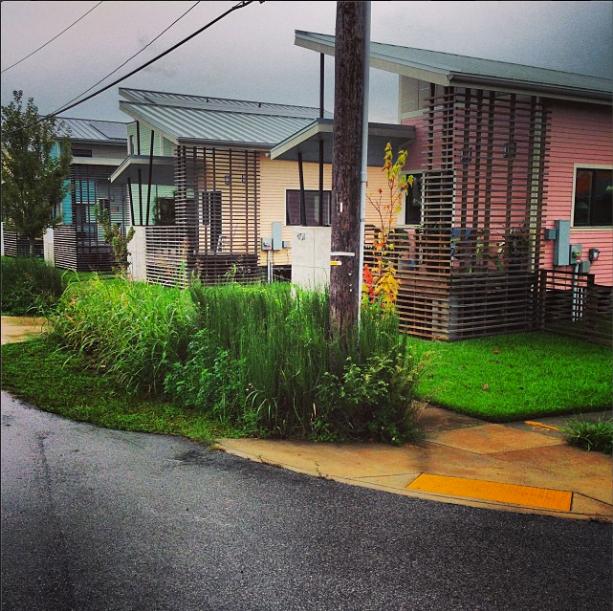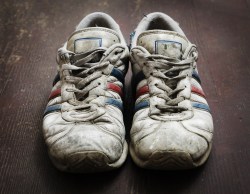Send your question to Umbra!
Q. Dear Umbra,
What can I do with my old tennis shoes? I have a closet full of shoes that are way too weathered and beaten up to donate to a food pantry or Goodwill, but are still quality material that I feel shouldn’t go to a landfill. Can shoe soles or leather uppers be upcycled?
Alison A.
Madison, WI
A. Dearest Alison,
One of my most cherished dreams is to design an entirely biodegradable line of shoes. But until my efforts with baking-soda paste and threads woven from invasive vines pay off, I share your common dilemma — a few too many pairs of tired tennies cluttering up the closet.
When you look at shoes in the broader context of the rest of our clothing, we’re shamelessly wasteful: According to the Council for Textile Recycling, the average American tosses 70 pounds of clothing per year. Of that, a mere 15 percent finds new life as industrial rags, insulation, carpet padding [PDF], seat stuffing, and even paper. The other 85 percent? Landfill.
But good news, Alison: There’s no need for your old kicks to join the waste stream. Before I get into recycling and upcycling options, though, are you absolutely certain your shoes have reached the end of their useful lives? Shoe repair outfits can work wonders these days. Cobblers can re-sole, re-heel, re-stitch, and replace everything from high heels to hiking boots to Birkenstocks. I even discovered a local shop in Madison that does climbing shoes.
Reviving your footwear whenever possible extends its useful life, not to mention saves you cash. But you specifically mentioned athletic shoes in your question, and they are a somewhat different animal. Because they’re pounded so much harder than your average slouchy boot, and because worn-out sneakers lack the proper cushioning and support to keep you pain- and injury-free, athletic shoes do come with a shorter lifespan. (There are, however, steps you can take to extend it.)
Also, you say that your gym shoes are too trashed to give away. But if there’s a chance someone could still walk a mile in your shoes, consider donating them. Plenty of organizations are standing by to accept your old sneaks, from the usual suspects such as Goodwill and the Salvation Army to groups that ship footwear to developing countries. If they can’t resell the shoes, major charity organizations often sell them to the textile recycling market, thus diverting them from the landfill while raising cash for a worthy cause.
But back to your original query, Alison: What to do with shoes that are totally exhausted? Practically every type you can think of — flip-flops, cleats, boots, what have you — can be disassembled and reused [PDF]. In some lucky cities, such as Newport, R.I., and Brockton, Mass., you can even place old shoes (and other clothing) in your recycling bin for curbside pickup. Madison is not among them, but your municipal recycling program does accept shoes at several dropoff locations. Might you be able to jog over to one of them?
Nike also runs one of the biggest athletic shoe upcycling programs out there, called Reuse-a-Shoe. Drop off your tennis shoes — any brand will do — at most Nike or Converse stores, and they’ll be ground up to build athletic tracks, turf fields, ball courts, and the like. Other brands will take their own models back for internal recycling.
If DIY is more your style, you can certainly get crafty with old kicks, too. Think sofa cushions. iPad covers. Utterly adorable baby moccasins. Then there are bookends, picture frames, vases, and birdhouses. Get thee to Pinterest and start exploring.
Of course, I would be remiss if I didn’t remind you that the bigger challenge here is not figuring out what to do with our piles of unwanted shoes, but reducing those piles by reining in our rampant shoe consumption. The Footwear-Industrial Complex is relentless in its quest to entice us to fill our closets with shoes of every stripe and style. A slightly outdated study from Consumer Reports reveals the average American woman owns 19 pairs. That’s a lot of surplus stilettos, when really one pair of sensible loafers would do.
So the next time you’re tempted, ask yourself how much you really need that new pair of adorable Mary Janes. And when you do purchase footwear, make it the high-quality, long-lasting variety. It may cost more, but it could serve you for decades, saving you money over the life of the shoe, and often supports better labor practices.
How often do you hear an environmental argument for $400 shoes? You’re welcome.
Sartorially,
Umbra




